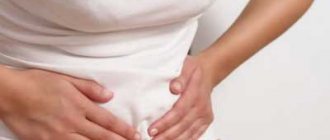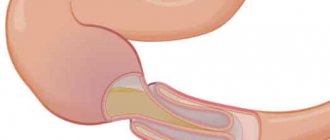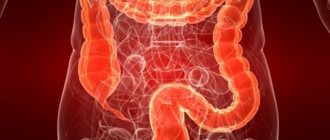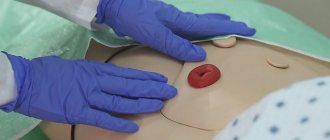Transversoptosis is a change in the anatomical position of the intestine. In the presence of the disease, prolapse or sagging of the transverse colon is observed, which resembles the letter V on X-ray photographs.
- Etiology
- Symptoms
- Diagnostics
- Treatment
- Possible complications
- Prevention and prognosis
Pathology can develop both during the period of intrauterine development of the fetus, and can be a consequence of other diseases. In some cases, provoking factors are physiological in nature.
The first clinical manifestation is increased gas formation, against the background of which other symptoms may occur: periodic pain in the abdominal area, attacks of nausea and vomiting, and other signs of deterioration in well-being.
The diagnostic process is based on the implementation of instrumental procedures, which are necessarily supplemented by laboratory tests and manipulations performed by the clinician.
After confirmation of the diagnosis, conservative attempts are made to get rid of the disease, for example, taking medications, following a diet and exercise therapy, but in the absence of positive dynamics, treatment is performed surgically.
According to the international classification of diseases of the tenth revision, pathology does not have its own code, but belongs to the category “Other intestinal diseases”. The ICD-10 code will be K55-K63.
Etiology
Intestinal transversoptosis is a rather rare disease that can be either congenital or acquired. Predisposing factors will vary slightly.
The following reasons are noted for congenital pathology:
- congenital weakness of the abdominal muscles;
- curvature of the spinal column, in particular lordosis;
- abnormal position of the diaphragm.
The secondary form develops against the background of other diseases or the influence of negative factors. In such situations, the provocateurs are the following:
- excessive stress on the intestines when engaging in strenuous sports;
- rapid weight loss;
- previous surgical interventions on the organs of the digestive system;
- features of the profession;
- difficult pregnancy;
- numerous births.
Often, a bend in the transverse colon in the area of the hepatic or splenic angle will be a consequence of the completely natural aging process of the human body.
In any case, the following changes occur in the organ:
- impaired intestinal motility;
- problems with the towing function;
- increased susceptibility to constipation;
- the occurrence of inflammatory processes;
- disturbance of peristaltic movements.
Intestinal structure
Description of the pathology and factors provoking its occurrence
Transversoptosis is characterized by bowing of the transverse colon. It becomes similar to the English letter V. Deviation leads to the formation of a pronounced inflammatory process.
With significant deviations, motor skills are impaired. Colon prolapse most often occurs in people over 50 years of age. The pathology equally affects both men and women.
The risk group also includes people whose work activities involve lifting heavy objects. The deviation is characterized by prolonged constipation. Without treatment, the patient's condition becomes worse. The reasons for the formation of the disease are described in the table.
| Hereditary predisposition | The risk of developing the disease is high in those patients whose relatives have encountered the deviation. Prenatal organ development disorders play an important role. |
| Body Features | Pathology can occur against the background of decreased muscle tone, low position of the diaphragm and weakness of connective tissue. |
| Excessive exercise | The disease may be a consequence of heavy lifting or excessive physical activity. |
| Features of body weight | People with excessive body weight or those who have spontaneously and significantly lost weight may experience the pathology. |
Symptoms and treatment of intestinal coloptosis in adults vary from person to person. For successful therapy, it is necessary to eliminate the underlying pathology.
Prolapse of the bowel is usually accompanied by prolonged constipation
Symptoms
The first clinical manifestations, which are most often ignored by people or attributed to completely different pathologies, are increased gas formation and frequent disturbances in bowel movements (constipation).
The following symptoms are typical for transversoptosis:
- pain in the lower or middle part of the anterior wall of the abdominal cavity of a constant, pressing and aching nature;
- a sharp increase in pain when straining during defecation or after eating food; excessive physical activity can provoke a painful attack - there is a decrease in the intensity of pain in a horizontal position of the body;
- periodic nausea, which only occasionally leads to vomiting - vomiting does not bring relief;
- severe headaches;
- causeless irritability;
- sleep disturbance, including insomnia;
- frequent mood changes;
- increased heart rate;
- increase in blood tone;
- signs of ischemic heart disease;
- fatigue and general weakness;
- unpleasant sensations during the emission of urine in males;
- painful menstruation in women;
- formation of external or internal hemorrhoidal cones.
Transversoptosis does not have specific clinical manifestations that would accurately indicate the course of this particular disease.
What is intestinal transversoptosis
Transversoptosis is a change in the anatomically prescribed position of the large intestine. As the pathology progresses, the transverse colon prolapses: on x-rays it will have the shape of the letter “V”.
Anyone can suffer from the disease, regardless of age and gender. There are a number of both pathological and completely harmless predisposing factors.
The main manifestation of the clinical picture is increased gas production. Against the background of this symptom, other signs develop: pain of varying severity in the abdominal area, periodic nausea leading to vomiting, and other manifestations of deterioration in well-being.
Prolapse of the transverse colon can only be detected using instrumental diagnostic procedures. Laboratory tests and primary diagnostic measures are only of an auxiliary nature.
Treatment begins with attempts to conservatively get rid of the problem by taking medications, following a gentle diet and performing exercise therapy. If there is no positive effect, surgical intervention is considered.
Diagnostics
Only a gastroenterologist can make a diagnosis of ceco-transversoptosis after the patient has undergone a whole range of diagnostic measures.
The clinician must personally carry out a number of manipulations:
- studying the medical history - to identify a pathological predisposing factor that could cause prolapse of part of the colon;
- familiarization with life history;
- collecting information regarding the course of pregnancy from female representatives;
- a thorough physical examination, necessarily including deep palpation of the abdomen;
- detailed survey of the patient - to establish the intensity and time of manifestation of the first symptoms of the disease.
The most important instrumental procedures in diagnostic terms:
- radiography of the peritoneum;
- ultrasonography of the gastrointestinal tract;
- irrigoscopy;
- radioisotope methods are the main methods for diagnosing the disease in children;
- gastroscopy;
- CT;
- MRI.
Gastroscopy under anesthesia
As for laboratory tests, analyzes are limited to general tests:
- clinical analysis and blood biochemistry;
- coprogram;
- general clinical urine analysis.
Transversoptosis must be differentiated from the following pathologies:
- irritable bowel syndrome;
- helminthiasis;
- pancreatitis;
- cholecystitis;
- intestinal obstruction.
Algorithm for diagnostic studies for suspected transversoptosis
As can be seen from the above information, the disease in question does not have clinical symptoms characteristic of it. There is not a single pathognomonic symptom by which this pathology could be reliably determined. All of the above symptoms can occur with any disease of the gastrointestinal tract - intestinal obstruction, irritable bowel syndrome, helminthiasis and many other pathologies.
In this case, it will be fundamentally important to correctly establish the diagnosis for the reason that there is a violation of an anatomical and not a functional nature (as with the same irritable bowel syndrome). And any disease of this kind requires the most responsible approach, since it will never go away “on its own.”
Without a doubt, assessing the objective status and performing deep palpation of the abdomen will be important, but these examinations are not enough to make a diagnosis.
It will be necessary to conduct a number of instrumental and laboratory studies. It all starts with an ultrasound examination of the abdominal organs - it will allow you to get a general picture and exclude the presence of cholecystitis, pancreatitis and some other pathologies that are in some way associated with functional disorders.
In any case, X-ray contrast examination (barium suspension is used) will be decisive for clarifying the diagnosis. The image will show a characteristic filling defect, usually in two places - this is the most characteristic radiological symptom for this pathology. In some cases (usually in pediatric practice), the radioisotope method is used along with fluoroscopy - this makes it possible to make the most accurate diagnosis, but the study is very expensive.
Treatment
Treatment begins immediately after confirmation of the diagnosis. After confirming the diagnosis, they immediately turn to conservative methods of therapy:
- maintaining a gentle diet;
- wearing a special bandage;
- therapeutic exercises;
- manual or hardware massage of the anterior wall of the abdominal cavity;
- taking medications to relieve symptoms;
- physiotherapeutic procedures, in particular paraffin baths, acupuncture, heating and medicinal electrophoresis;
- the use of traditional medicine, but only as an auxiliary treatment method and after the approval of the attending physician.
Diet therapy has a number of strict rules:
- eating large amounts of high-calorie foods;
- enriching the menu with fermented milk products, fruits, honey and sugar;
- ingestion of sufficient volumes of liquid - at least 2 liters per day;
- consumption of sweets (transversoptosis is one of the few diseases for which carbohydrates are allowed).
Treatment with folk remedies at home involves preparing healing infusions from the following components:
- sagebrush;
- buckthorn;
- yarrow;
- Oak bark;
- caraway;
- dill;
- fennel.
The disease should be treated with surgery only for the following indications:
- the appearance of signs of intoxication;
- detection of acute or chronic intestinal obstruction during instrumental examination;
- constant pain syndrome;
- failure of conservative methods of therapy.
Surgical treatment is carried out in several ways:
- resection of part of the transverse colon and securing the remaining part to the posterior wall of the peritoneum, positioning it transversely;
- suturing the transverse colon with the stomach;
- segmental coloplication or reduction in intestinal length in children.
Exercise therapy and gymnastic exercises
If pathology is present, the patient is recommended to exercise moderately to improve blood flow and reduce the intensity of symptoms. Here are some effective exercises for bowel prolapse:
- in a lying position, raising two legs and holding them suspended for 5 seconds;
- imitation of cycling;
- in a lying position, pressing your legs to your stomach;
- performing the scissors exercise.
Therapeutic treatment can be achieved with the help of special exercises
Therapeutic exercises for prolapse of internal organs and intestines are highly effective and can significantly improve the condition. In addition, there is a positive effect on the entire body.
Treatment must be started immediately if symptoms are severe. Procrastination is dangerous to health. Massage for bowel prolapse also has proven benefits by doctors. It is allowed to independently stroke the surface of the abdomen to reduce pain.
Prevention and prognosis
These simple preventive rules will help reduce the likelihood of developing the disease;
- maintaining a healthy and moderately active lifestyle;
- proper nutrition;
- strengthening the abdominal muscles;
- avoiding excessive physical activity;
- body weight control;
- Regularly undergoing a full medical examination.
The prognosis for transversoptosis is favorable. However, we should not forget about the development of complications, so postponing treatment is not recommended. The danger lies in the fact that even after surgery the possibility of frequent relapses of transverse colon prolapse cannot be ruled out.











